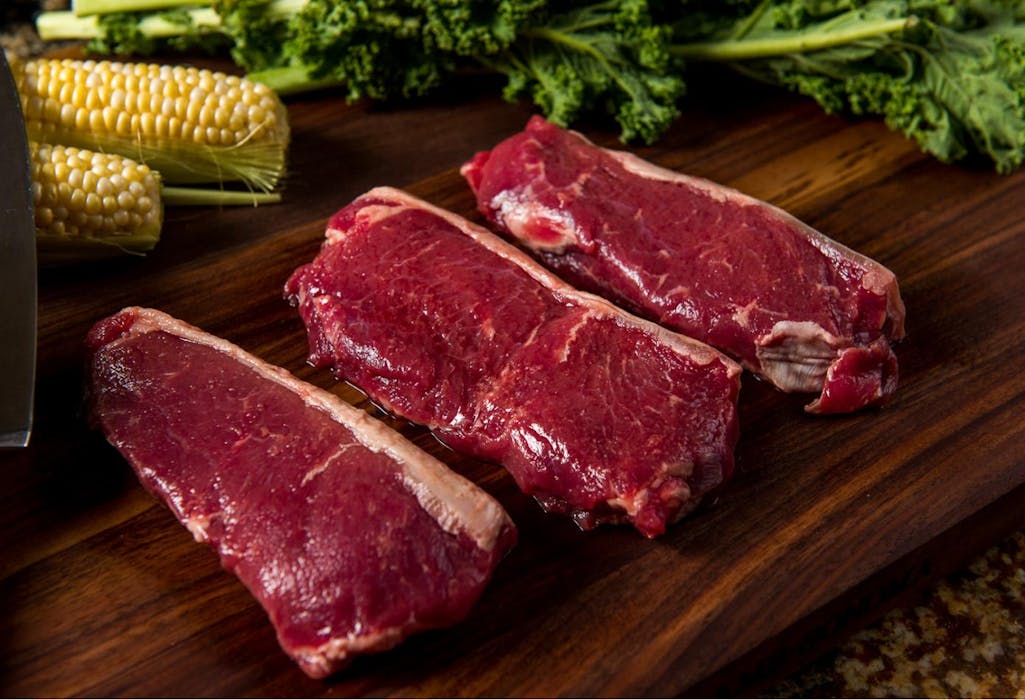
If you pay attention to food trends, you’ve probably been exposed to the hype about grass-fed beef. Between health experts touting its virtues as a nutritious alternative to other kinds of red meat and chefs praising its unique and powerful flavour, grass-fed beef has easily become one of the hottest meats of the past few years. But is it really worth all the hype?
For those of us who are passionate about healthy, humanely raised local meat, the grass-fed beef explosion is one of the most exciting food trends of the decade. But we know that many people have mixed feelings about it upon first taste. Grass-fed beef is, indeed, a healthy and delicious alternative, but it can also be a bit of an acquired taste, and the very things that make it nutritious — its leanness and different fat profile — can pose a challenge for people used to cooking grain-finished beef.
If you want to learn how you can get the most out of grass-fed beef, here are a few things you should know about what makes your grass-fed steaks special, and how you can get the best results when cooking them.
What Makes Grass Fed Beef Unique
Grass fed beef is one of the biggest trends in North American food right now, but there are a lot of misconceptions about what makes grass-fed beef unique. Is grass-fed beef really better for you than grain-finished? Is there actually a significant difference in flavour? Isn’t all beef grass fed at some point in its life?
In order to answer these questions, and to help you understand what makes Ontario grass fed beef distinct from other kinds of Ontario beef, it is important to explain what the label “grass fed” actually means. Almost all cattle raised in Canada starts its life eating a variety of different forage, including nutrient rich alfalfa and other local grasses. What makes grass-fed beef different is the fact that it comes from cows that have only been fed forage, rather than having their diet supplemented with grain-based feeds once they are approaching maturity.
The introduction of grain into a cow’s diet helps it put on weight faster, and shortens the time before it can be sent on to be slaughtered and processed. Grain isn’t bad for cows, but grain feeding is often associated with large feedlot operations, where cattle are fattened up on corn and soy. Feedlots usually try to pack in as many animals as possible, both to economize space and to speed up the fattening process, and if you’re buying
That being said, some cattle operations do use a mix of grain and forage when raising their cattle, so just because beef is not labelled “grass fed” does not mean it has been raised on a feedlot (for example, at truLOCAL we work with several local farms that raise beef that has been humanely and sustainably produced, but which isn’t technically grass fed). Grain does, however, change the quality, texture, and flavour of the meat, and one of the reasons why grass-fed beef has become so popular is because many people prefer the earthier, richer flavour that comes when cattle are raised purely on forage.
Chefs and dietary experts have noted when comparing grain-finished beef to grass fed that grain-finished beef is more tender, and grain-finished steaks, in particular, tend to have more fat marbled through the meat. This makes sense, as the point of introducing grain into a cow’s diet is to fatten it up more quickly. Grass-fed beef, on the other hand, is leaner, darker, and has a beefier, gamier flavour. This is because the more complex diet of grasses and forage imparts are a stronger, more pronounced flavour to the meat.
While there are partisans on both sides of the grass-fed/grain-finished divide, the notion that one is more healthy or humane than the other is largely untrue. What matters far more than the diet is the environment in which the cow was raised, and one of the reasons we put such stress on the importance of going local is because buying local beef from farmers that are committed to sustainable farming practices is the best way to guarantee that, grass-fed or grain-finished, the beef you are getting is good for you, and good for the environment.
Cooking Tips for Grass Fed Beef
That being said, grass-fed beef has a different flavour and nutrient profile, and getting the most out of grass-fed beef means learning how to work with the strengths of this kind of meat.
Not everyone has a good experience with grass-fed beef the first time around. Too many people unbox their first order of grass fed steaks and think they should simply cook them the way they would cook a grain-finished steak. The problem is, because grass-fed beef is so much leaner than grain-finished, it tends to cook faster and dry out more easily. The same amount of heat and time needed to get to a juicy medium rare when cooking with conventional beef will yield a tough, dry, grass-fed steak.
This doesn’t necessarily mean that grass-fed beef is more difficult to prepare, it just means you have to be more careful about making sure that it isn’t overcooked.
Another common complaint is that grass-fed beef is too “strong,” that its flavour can be overwhelming. This is often as much a matter of taste like anything else (North Americans tend to be used to the lighter taste of grain-fed beef, but for those who eat game like duck, venison, or moose, the grass-fed earthiness will be comfortingly familiar), but there are ways you can use the more robust taste of grass-fed beef to your advantage.
If you’re new to grass-fed beef, here are a few kitchen tricks you can use to bring out the flavour and texture more effectively:
- Marinade the meat overnight before cooking. A marinade will make your cut of beef moister, and will reduce the chances of it drying out in the pan or oven. Tenderizing steaks before marinating is also a great way to ensure they soak up as much of the flavour as possible.
- Use more cooking fat. You can offset the leanness of grass-fed beef with more butter or oil. This is especially important if you are pan-frying the steak. Searing the steak on a high heat and then cooking the steak alongside onions or peppers is also a good way to trap in as much moisture as possible.
- Shorten the cooking time, and make sure you let it sit. Meat continues to cook after it has been removed from heat, so in addition to reducing the cooking time for grass-fed beef, it’s a good idea to let it sit for around ten minutes. This will guarantee that your steak is done all the way through, and achieves that tender consistency you want in a good piece of beef.
- Avoid microwaving. Because we deliver truLOCAL grass-fed steaks frozen and individually wrapped, it can be tempting to want to defrost them up in the microwave so you can enjoy them as quickly as possible. Unfortunately, this will cause the meat to contract and toughen up before it’s even started to cook. Instead, let them defrost slowly in the refrigerator, or sitting in a bowl of water.
Grass-fed beef requires some adjustment if you’re only used to grain-finished, and you may not get it right the first time. Don’t let this discourage you! Once you figure out how to use its unique qualities to your advantage, grass fed beef is a rewarding and delicious ingredient to work with.
Turbocharge Your Keto Diet with Fresh Grass Fed Beef
While grass-fed beef is a good addition to any diet, there is one group of eaters who can benefit from it in particular: those on the ketogenic diet. Keto dieters dramatically reduce their carb intake while increasing the amount of fat they eat, putting their bodies into a state known as ketosis. Because this diet is so reliant on healthy fats, keto eaters need to avoid dangerous trans fats and make sure their fat intake includes large amounts of Omega-3 fatty acids.
Grass-fed beef has been proven to contain much higher quantities of Omega-3 fatty acids, which has made it a popular choice among those trying to go keto.
But it isn’t just that grass-fed beef contains significant amounts of healthy fat: meat quality is very important for the keto diet in general. Keto expert often make a distinction between “clean” and “dirty” keto, with dirty keto being much heavier in greasy, unhealthy food. You can take the bun off a bacon cheeseburger and technically still be eating a keto meal, but that doesn’t mean it is necessarily good for you, and in the long run, this kind of reckless approach to eating will take a toll.
For that reason, most dieticians will advise keto eaters to emphasize healthy foods that are as minimally processed as possible, and which provide a range of nutrients that keto eaters may not be getting from carb-rich foods. The fact that grass-fed beef provides a reliable source of iron, protein, and conjugated linoleic acid (CLA) makes grass-fed beef a perfect way to increase nutrient intake without throwing off your macros.
If you’re on the keto diet and you want to know how truLOCAL’s fresh meat delivery system can help you eat as clean as possible, check out our wide range of meat products and get started building your own meat box today. With plenty of exciting options to choose from, including a wide selection of grass-fed cuts, truLOCAL makes turbocharging your keto diet with fresh grass-fed beef easy.
Get Grass Fed Beef Delivered to Your Door
Grass-fed beef was almost unheard of even a few years ago, and while that is changing rapidly, it is still the case that people without access to quality grocery stores or specialty butchers often have a hard time getting access to local grass-fed beef. Oftentimes, the only way to get grass-fed beef delivered is through bulk purchases that require lots of freezer space.
One of the things that makes truLOCAL unique is our commitment to making fantastic local meat accessible to everyone, which is why we’ve designed a delivery system that lets our customers choose the meats they want, and how often they want them delivered (you can click here to learn more about how you can get started on your own order today).
If you’ve never tried grass-fed beef before and you’re curious to see what it’s like but don’t want to commit to buying a large quantity, you can include one or two cuts in your meat box order to try. If you like it, you can increase your order, or you can replace it with other meats you prefer. And unlike other delivery services, we don’t require contracts, so you can pause, increase, or cancel your subscription at any time.
Grass-fed beef is often described as being an acquired taste. Once you have it, though, you’ll probably be a fan for life. If you want to find out for yourself why so many connoisseurs are excited about local grass-fed beef, order a truLOCAL meat box now, and within a couple of days, you can have a refrigerated box of premium grass-fed steaks delivered to your door anywhere in Ontario, British Columbia, or Alberta. Getting the most out of grass-fed beef has never been easier!
Posted on
July 12th, 2021







